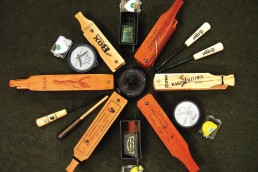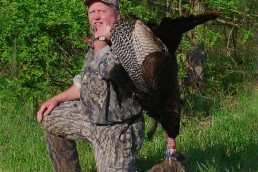Turkey Vest Essentials
SHARE THIS POST
Veteran turkey hunters are pickier than an old turkey hen about what they carry in their vests when sneaking through the woods. Novices seem to go two ways: forgetting something essential or bringing everything but the kitchen sink. But veteran turkey hunters do a “vest dump” and find out just what they need to carry each time they’re out.
Many use a dedicated turkey vest with small and large pockets to carry everything, and in the right place. Many models have a padded backrest and seat for when that long-beard tom takes his time coming to a call. Also ideal are a small set of binoculars to peer through thick undergrowth. Binoculars narrow your field of focus and help you differentiate between hens, jakes and toms in the thickets and tall grasses, hopefully long before they spot you.
Having a ThermaCELL insect repellant unit helps. These are coveted by turkey hunters because of the protection they provide against biting insects. Just bring spare fuel and pads for it. In addition, have a small container of spray insect repellant and a face or head net.
Few things give away your presence faster than a pale face as the sun reflects off it, so use camo face paint. Even if you use a face net, dark face paint under the eyes diminishes reflected sunlight and makes it easier to peer into the shadows of the forest. Bring camo gloves with a long cuff because turkeys key in on movement, especially when your skin is exposed.
Are you enjoying this post?
You can be among the first to get the latest info on where to go, what to use and how to use it!
Have a small flashlight, preferably with a red or green lens. Dealing with gate locks, finding dropped items, or checking for poison ivy before sitting down can all be found with one. A red or green lens lessens the chance of alarming wildlife too, and has less affect on night vision.
Use a disk call and strikers. A disk call works wonders when making those purrs and clucks to put hens at ease or when they get worked up and mad. Different strikers can change the tones of the call for more realism. Have a box call too. Few calls are easier to master, but make sure you keep a rubber band around it when not in use to keep it from chirping while moving around.
For more tools, bring sharp pruning shears. You never know when that perfect setup has a branch or two in the way. Plus, you may need to make a blind with a few well-placed branches, just enough to break up your outline. Have a small folding saw for the same reasons, but for the larger limbs.
For calls, keep an owl call handy. These can be used to locate roosting turkeys before sunup and during the day. Use a crow call, as these too can locate turkeys. A gobble call locates toms, but for safety’s sake, only use it if you’re on private ground and know positively that no one else is close by who could mistake you for a turkey. Remember to bring along those mouth/diaphragm calls. Finally, have a call-freshening kit of sandpaper, chalk and scouring pad.
MWO
SHARE THIS POST
Did you enjoy this post?
You can be among the first to get the latest info on where to go, what to use and how to use it!
MWO
We believe being outdoors is good. With more than 1,000 articles each year, MidWest Outdoors magazine is all about sharing outdoor experiences with you—where to go, what to use and how to use it… whether you’re close to home or on that trip of a lifetime.



